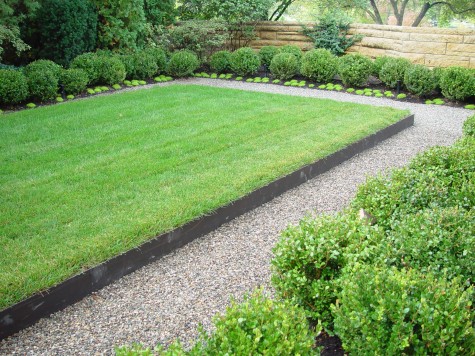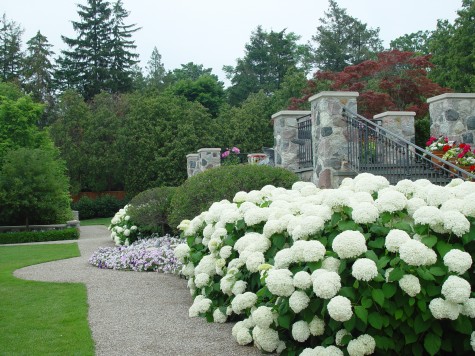 A verge is the absolute boundary between one space and another. The Brits call the edges on their garden beds “verges”. Years ago, taking the time to cut clean deep edges on beds with a sharp square spade for clients, asked for a name with some romance. Cuuting a verge made me feel like I was doing important work. Edging beds-not so much fun. I would fill those verge ditches with bark-to keep the grass from invading. Edging beds and walks with steel or aluminum edging is an expensive investment that dramatically lowers maintenance time over the lifetime of a landscape. In this garden, I had no interest in grass invading the gravel walks. A steel verge keeps the spaces cleanly different. Grass meets gravel. Grass and gravel coexist beautifully.
A verge is the absolute boundary between one space and another. The Brits call the edges on their garden beds “verges”. Years ago, taking the time to cut clean deep edges on beds with a sharp square spade for clients, asked for a name with some romance. Cuuting a verge made me feel like I was doing important work. Edging beds-not so much fun. I would fill those verge ditches with bark-to keep the grass from invading. Edging beds and walks with steel or aluminum edging is an expensive investment that dramatically lowers maintenance time over the lifetime of a landscape. In this garden, I had no interest in grass invading the gravel walks. A steel verge keeps the spaces cleanly different. Grass meets gravel. Grass and gravel coexist beautifully.
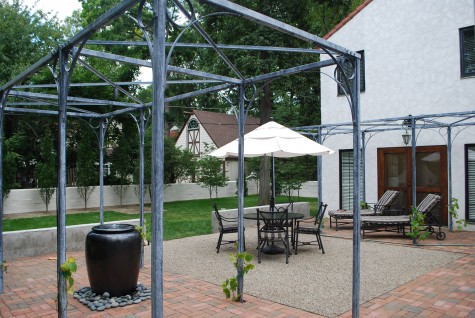
Steel or aluminum edging shines on a terrace made of multiple materials. The extreme boundary of the gravel portion of this terrace is equal to the extreme boundary of the brick portion of this terrace. The transition space-probably 1/8th of an inch wide. A very crisp verge dresses up a space.
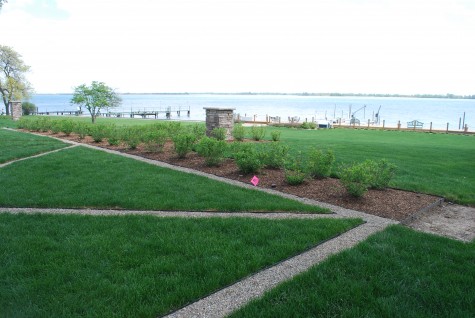
Lawn and decomposed granite share one tendency-they both will spread out and blur the edges of the shape of a space, unless contained. Blurred edges suit some landscapes. I love those English style perennial gardens where the gravel is actually a mulch. You know of which I speak-those perennials billowing over the gravel in a pattern much about plant habit, and that one random perennial thriving in the gravel. The seed that managed to germinate, the plant that managed to take hold in the gravel, the gardener that directs all traffic around that one volunteer so beautifully out of place-this garden has no use for verges. This particular design-aluminum verging was a must.
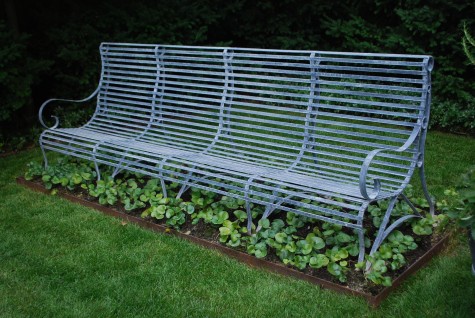 My steel bench sits on a platform set at exactly the height of my pool coping. That platform is edged in steel. I like the pool and bench platform set some above the lawn panel. The why is simple. I am very interested in the description that landscape makes of the ground plane. Multiple ground planes I find interesting. Rather than ascribe this to an estoteric aesthetic ,living on minutae, I would suggest a bigger picture. The lay of the land is a very important part of the beauty of a landscape. Work the sculpture that is the ground- before you plant.
My steel bench sits on a platform set at exactly the height of my pool coping. That platform is edged in steel. I like the pool and bench platform set some above the lawn panel. The why is simple. I am very interested in the description that landscape makes of the ground plane. Multiple ground planes I find interesting. Rather than ascribe this to an estoteric aesthetic ,living on minutae, I would suggest a bigger picture. The lay of the land is a very important part of the beauty of a landscape. Work the sculpture that is the ground- before you plant.
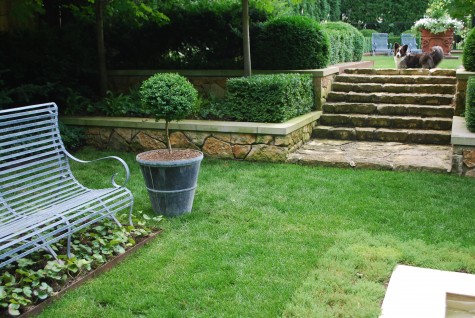 My stone retaining walls are edges, verges, on a much bigger and more noticeable scale. Edging makes a dramatic change of material possible in a subtle way. The changes of grade in my garden are no doubt my most favorite thing about it. I think my landscape would be just as beautiful planted with grass everywhere, as it is now. Picture your entire property planted with grass-would it enchant you? If not, look at how you have sculpted your ground. Start with a beautifully sculptural ground plane. A great landscape design will feature the underlying structure of your land.
My stone retaining walls are edges, verges, on a much bigger and more noticeable scale. Edging makes a dramatic change of material possible in a subtle way. The changes of grade in my garden are no doubt my most favorite thing about it. I think my landscape would be just as beautiful planted with grass everywhere, as it is now. Picture your entire property planted with grass-would it enchant you? If not, look at how you have sculpted your ground. Start with a beautifully sculptural ground plane. A great landscape design will feature the underlying structure of your land.
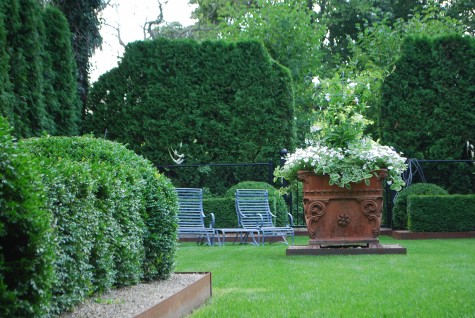 My side city half lot is very small. I dug out the ground plane-I thought a sunken garden would be the most significant gesture I might make in a small space. Lowering the ground 8 inches-I had to go to Buck for edging for retaining that lowered space. I had no room to roll and feather down to the lower level. He made thick steel edging for me some 11″ wide. And the corners, stakes, and connectors to go with. Photographing from the fountain garden grade, you can see what my low riding corgis see every day-a gorgeous change of grade.
My side city half lot is very small. I dug out the ground plane-I thought a sunken garden would be the most significant gesture I might make in a small space. Lowering the ground 8 inches-I had to go to Buck for edging for retaining that lowered space. I had no room to roll and feather down to the lower level. He made thick steel edging for me some 11″ wide. And the corners, stakes, and connectors to go with. Photographing from the fountain garden grade, you can see what my low riding corgis see every day-a gorgeous change of grade.
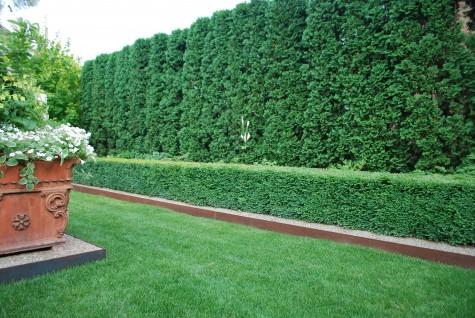 The steel platform for my English concrete pot is new this year. The 1/4 inch hot rolled, pickled and oiled steel is still that blue- grey color. It will not take long to rust up, and turn brown. This landscape-very simply about the sculpture that is the ground. Sculpture in the landscape is important to me personally. Knowing what is important to you in your landscape is incredibly important before you dig any holes.
The steel platform for my English concrete pot is new this year. The 1/4 inch hot rolled, pickled and oiled steel is still that blue- grey color. It will not take long to rust up, and turn brown. This landscape-very simply about the sculpture that is the ground. Sculpture in the landscape is important to me personally. Knowing what is important to you in your landscape is incredibly important before you dig any holes.
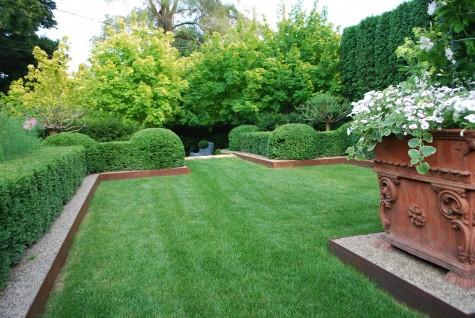 I have lived in my house, on this property, some 15 years. My small 1.5 city lot plot demanded much more thought than action. I am happy with my verges, no matter where they might be. The edges of a landscape composition are very important. Painters-they are so lucky to have that frame around what they paint. Landscape design-the edges need to be discovered, and marked. This process can take a lot of time. Lucky for every gardener, the earth has much more time than you do. Nature favors any work you do, in the long run.
I have lived in my house, on this property, some 15 years. My small 1.5 city lot plot demanded much more thought than action. I am happy with my verges, no matter where they might be. The edges of a landscape composition are very important. Painters-they are so lucky to have that frame around what they paint. Landscape design-the edges need to be discovered, and marked. This process can take a lot of time. Lucky for every gardener, the earth has much more time than you do. Nature favors any work you do, in the long run.
This raised grass panel, beautifully edged in steel, is not my design. My client’s interior designer engineered this for her. He may not know the verge word, but he understands everything about space and sculpture, does he not?
